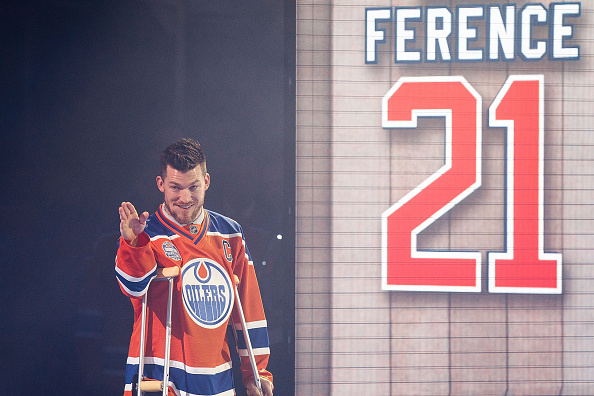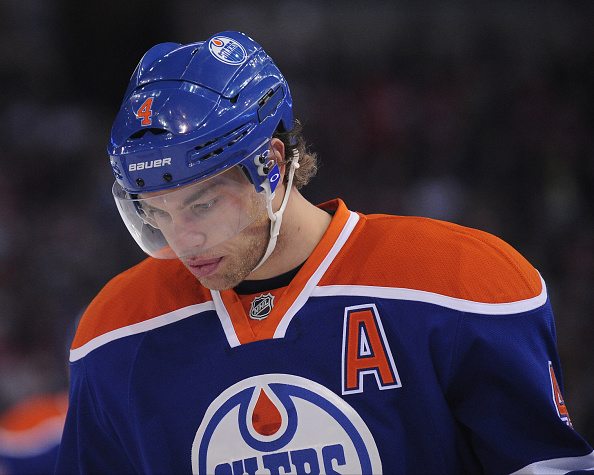Believe it or not, the Edmonton Oilers are in their Stanley Cup window.
It sure doesn’t feel that way after watching the organization finish at or near the bottom of the league standings for much of the past decade. But Edmonton’s best chance for a Stanley Cup is with Connor McDavid on his entry-level contract and other rising stars locked in at manageable cap hits.
But here’s why that isn’t going to happen.
The Edmonton Oilers are now a ‘cap team’. McDavid is two summers away from possibly commanding upwards of $10M per season on his next contract. GM Peter Chiarelli will be forced to strategically consider salary cap implications before making any moves to improve his roster.
Ask Chicago, Pittsburgh and Los Angeles about life at the cap ceiling and they’ll show you a list of valuable assets that had to be dumped or sold for pennies on the dollar. Those teams and their respective GM’s have maintained success despite limited salary cap flexibility, but can we really expect Chiarelli to significantly improve the Oilers under the same cap constraints?
A little luck definitely helps.
Chiarelli entered the 2016 draft looking to facilitate a trade for a top defenseman (or three…). Edmonton’s needs are no secret and they held the #4 pick in the first round. Chiarelli struck out in the trade market on the draft floor in Buffalo, but luck came his way when consensus top-three pick Jesse Puljujarvi landed in his lap.
Most assumed the Oilers would end up with Pierre-Luc Dubois, a big winger out of the QMJHL who probably still needs seasoning before making the jump to the pro ranks. Puljujarvi, on the other hand, answered “Yeah, of course” when asked if he was 100 percent ready to play with the Oilers this season.
With that expectation of NHL playing time comes the need for Chiarelli to fit him into the 2016-17 salary cap puzzle. Base salaries for players like Puljujarvi on entry-level contracts is maxed at $925k, but performances bonuses are where teams can get into trouble.
Winnipeg’s Patrik Laine, the second overall selection in this year’s draft, has the opportunity to earn $2.65M in bonuses on top of his base salary. Puljujarvi should receive roughly the same amount when he signs. On top of that, Connor McDavid ($2.85M), Leon Draisaitl ($2.475M), Griffin Reinhart ($2.35M), Darnell Nurse ($850k) and Anton Slepyshev ($600k) are just a few of the Oilers who also have large potential bonuses structured into their contracts.
What that means is while GeneralFanager.com shows the Oilers with over $9M in cap space when accounting for next year’s base salaries, Chiarelli effectively has none.
Edmonton Oilers Current Cap Situation
The scenario above shows the precarious situation Chiarelli finds himself in even after freeing up $1.8M in cap space with the Taylor Hall for Adam Larsson trade. Here are the significant things to note:
- It’s assumed that Slepyshev, Reinhart, Oesterle, and Brossoit are all in the AHL for purposes of this calculation.
- Edmonton created some cap flexibility by buying out Lauri Korpikoski ($2.5M hit reduced to $500k for next year) just prior to free agency. At that point, Chiarelli probably knew the Oilers had a very strong chance of bringing in Milan Lucic on July 1.
- Lucic accepted less money and less term (Los Angeles offered him 8 years) on his $42M contract with Edmonton. This wasn’t just a favor to Chiarelli, his former GM in Boston. The Oilers really couldn’t afford a larger cap hit.
- McDavid and Nurse should be locks for the NHL roster next year. Draisaitl’s spot could theoretically be debated — as it was when Chiarelli initially buried him in the AHL for the same cap reasons last year — but he showed that he deserves to stick in the NHL.
- Puljujarvi hasn’t signed his ELC yet, but the scenario above assumes he makes the team and receives the same contract as Draisaitl, the third-overall pick in the 2014 draft. Puljujarvi obviously expects to be in the NHL. Could Chiarelli use this as a bargaining chip to keep the bonuses down? If not, Puljujarvi could spend the first half of the season in Bakersfield (AHL).
- Griffin Reinhart is likely the odd-man out on defense. Chiarelli gave up a first- and very high second-round pick last summer to acquire Reinhart, but his bonus situation makes it all but impossible to squeeze him in for the time being. I’m not even sure where he fits long-term with left defensemen Klefbom, Nurse and Davidson also on the roster.
Salary cap gurus may be wondering why the Oilers have to fit all base salaries and bonuses under the cap ceiling of $73M. The CBA allows teams to exceed the ceiling by 7.5 percent ($5.5M next year) during the season as a result of potential performance bonuses. To the extent that the team finishes the season with base salary plus achieved bonuses in excess of cap ceiling, the overage carries over as a penalty to the following year.
But the bonus cushion isn’t a reasonable option for Edmonton. Blame Andrew Ference.
Ference isn’t expected to play for Edmonton this season due to a hip problem that limited him to only six games last year. It’s impossible to buy out injured players, which means the Oilers’ only option for relief is long-term injured reserve (LTIR).
LTIR, despite common misreporting, doesn’t allow for a cap hit to come ‘off the books’. Instead it allows a team to spend in excess of the ceiling up to the amount of the injured player. But combining the dynamics of LTIR with performance bonuses effectively means that teams are guaranteed to get hit with a penalty for all bonuses achieved.
Chiarelli learned about this situation the hard way.
After Boston famously missed out on Jarome Iginla at the 2013 trade deadline, Chiarelli jumped at the opportunity to sign him in free agency a few months later. The salary cap dropped significantly that summer, leaving Chiarelli with only one option to get ‘his guy’: a bonus-laden deal with a base salary of just $1.8M but the opportunity for Iginla to easily earn $6M total through bonuses.
Boston had Marc Savard ($4M cap hit) playing the role of Andrew Ference above and chose to place him on LTIR for relief. Iginla (and others) hit their bonuses in 2013, while the Bruins were left with no Cup and a $4.8M penalty to show for it.
The penalty forced Boston to trade Johnny Boychuk the following summer, which left a massive hole in the Bruins’ defense, which eventually cost Chiarelli his job.
To summarize: Yes, Chiarelli has the ability to squeeze all of his young players onto the roster and simply live with a bonus penalty next season. There’s just absolutely no way he takes that approach.
What are the terms of Edmonton’s bonuses?
The situation we’ve outlined above partly relies on players such as McDavid actually achieving their ELC bonuses. We’ve added bonus details for McDavid, Draisaitl and Nurse on the player pages at GeneralFanager.com, but let’s take a deeper look at McDavid for context:
- $850,000 Schedule A bonuses, $2,000,000 in Schedule B bonuses in all years.
- Schedule A bonuses (max $850,000): $212,500 for any of the following achievements – top 6 forward on team in ice time (total or average per game, min 42GP), 20 goals, 35 assists, 60 points, 0.73 points per game (min 42GP), top 3 forward on team in +/- (min 42GP), All Rookie team, All Star game, All Star game MVP.
- Schedule B bonuses (max $2,000,000): $2,000,000 for any of the following achievements – top 10 forward in the league in goals/assists/points/points per game (min 42GP), top 5 in league in Hart/Selke/Richard voting, NHL First or Second team all star.
McDavid easily maxed out his Schedule A and B bonuses based on performance this year (and should do so again next year) but just barely reached the standard 42GP threshold as a result of his shoulder injury. This is an interesting piece to keep in mind when it comes to Reinhart and Puljujarvi for the upcoming season.
Smart cap teams start young players in the minors with hollow justification like “he needs to adjust to the North American game” or “we want him to build up his confidence” only to seemingly lose those concerns once the player is no longer eligible for 42 games and his Schedule A bonuses.
For example, Pittsburgh sent Derrick Pouliot ($425k in eligible bonuses) to the AHL to start the season with the following message from GM Jim Rutherford: “He worked real hard. He’s real close to being here and helping the team. Right now, it’s to get him to play some games and get his confidence up with handling the puck, he should return here at some point.”
Pouliot definitely needed the development but he also was a bonus risk for the first half the season with the Penguins tiptoeing in and out of LTIR. Fast forward to mid-January, after Game 42 when his Schedule A bonuses were no longer possible, and Pouliot was back up on the NHL roster to stay.
Why did the Oilers trade Taylor Hall?
In a vacuum, the Taylor Hall for Adam Larsson trade was highway robbery for Ray Shero and the New Jersey Devils. Hall has upside of 100 points someday with the right linemates (although he may not have that luxury in NJ), while Chiarelli says Larsson will be a #2 defenseman on the Oilers someday.
The reality is that Chiarelli probably wasn’t going to get a defenseman for Taylor Hall that both (1) had more talent than Larsson and (2) allowed Edmonton to open up cap flexibility for free agency…at least not in the window prior to July 1 anyway.
Let’s look at it from another angle: Chiarelli effectively gave up Hall ($6M) and $4M of open cap space and ended up with Larsson ($4.2M) and Lucic ($6M, free to acquire). Not quite as lopsided a trade in that light.
What’s next for Edmonton and Chiarelli?
While the cap scenario above looked complete, I don’t think the Oilers are quite finished yet.
$250k of space looks fine on a static spreadsheet on July 4, but it’s far more difficult to manage a roster like this during the season. Chiarelli could use some additional cap flexibility and also admits he wants to find a right-handed #1 defenseman to run the Oilers’ powerplay.
A deal involving Ryan Nugent-Hopkins and Colorado’s Tyson Barrie as major pieces seems like a no-brainer at this point. Nugent-Hopkins makes $6M and seems destined to slot in at Edmonton’s third-line center role behind McDavid and Draisaitl for years to come. Barrie is a restricted free agent that should command slightly less than $6M on his next deal but would solve Edmonton’s #1 defenseman needs. For whatever reason, it sounds like Avs GM Joe Sakic has made him available, so the potential is there.
Chiarelli obviously won’t be the only GM looking to grab Barrie and other suitors may have more cap flexibility to make it happen than Edmonton does at the moment.
It won’t be easy to take the Oilers from the bottom of the standings to a playoff spot (and beyond) overnight. But as crazy as it sounds, the clock is ticking on the Oilers’ Stanley Cup window.
Oilers fans are hoping Peter Chiarelli has learned from his salary cap mistakes.




